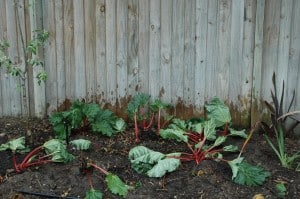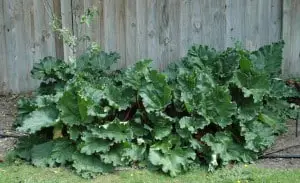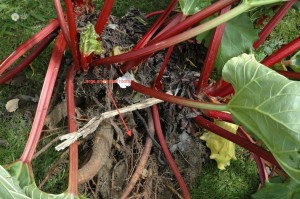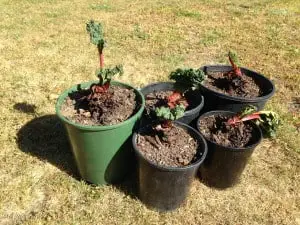Contents
Years ago I was given a Rhubarb plant from a work colleague.
I’ve talked before about the journey of this poor neglected plant into my garden. The short of it is that it was left to dry out, forgotten in a garage, then eventually sent my way where it got (accidentally this time) left for another day to dry out, then finally planted in the garden to flourish.
As I said in that post, Rhubarb plants are tough. They are extremely resilient and while I wouldn’t recommend treating them badly like my first plant was, they can tolerate a fair bit of unkindness.
It’s been at least 18 months since my Rhubarb plants found their current home, and at that time they were split off from the original plant to create 5 new plants.
Dividing Rhubarb up is not only useful for propagating more plants, it’s also important for keeping the original plant healthy. The bigger it gets, the thinner and fewer the stems tend to be, and the whole plant can get a little out of control.
Which is where our Rhubarb patch had got to.
It needed splitting up to keep it in it’s best shape, plus I had offered a plant to my best friend so it was time to get chopping.
How To Divide Rhubarb
Dividing (or splitting) Rhubarb is really easy. It can seem a little barbaric when you’re doing it but, I promise, you’ll be richly rewarded for your brutality.
The best time to divide your Rhubarb is in early Winter when the plant growth has slowed or is dormant, or in early Spring as the new buds are forming. I prefer to do it in early Spring so I can see which parts of the crown are looking healthiest and have the most new buds ready to come up.
The first step to start dividing the plants is to carefully lift the plant you want to split, out of the ground.
Because you want to keep as many roots (or rhizomes in the case of Rhubarb) on the plants you split off as possible, you need to use a garden fork and lift the plant from about a foot from the crown of the plant.
Once you have the plant out of the ground you’ll be able to see how many plants you can split the mass up into. You’re looking for multiple crowns that have their own roots/rhizome attached. As you can see in the picture below there are a number of obvious new parts of the plant, as well as the thick rhizome/root and some smaller roots.
When you’ve identified where you want to split the plant you then need to take a sharp, clean spade, and get ready to start chopping.
Use the spade to slice the plant through the bulk of the root system separating off one part of the crown (with roots attached) at a time.
Continue to do this until you have split off all the extra plants. You might find you have a few failed slices where you end up with a plant with barely any roots. Hopefully, if your original plant is a good size, this won’t matter and you’ll still end up with plenty of extra plants.
Replanting Rhubarb Crowns
Once I’ve divided all my plants up I take the strongest looking plant with new buds and replant it back into the patch.
Make sure when you’re replanting your plants that you set them into the ground at the right height, keeping the crown above the soil level.
I also like to lay down some fresh compost under the roots before planting, and then over the surface around the crown for a nutrient boost.
You’ll find that some of the stems will sulk after replanting, but the new buds will be ready to burst into the bright, warm sun as soon as you’ve provided plenty of water and given them a few days to recover from the shock of being divided and moved.
 It’s worth trimming off any stems that are damaged or looking unhealthy so the plant can put all it’s energy into settling back in and growing. And remember, don’t just throw those lovely big green leaves on the compost. Rhubarb leaf pesticide is a great, organic product that can be used to maintain other parts of your garden.
It’s worth trimming off any stems that are damaged or looking unhealthy so the plant can put all it’s energy into settling back in and growing. And remember, don’t just throw those lovely big green leaves on the compost. Rhubarb leaf pesticide is a great, organic product that can be used to maintain other parts of your garden.
Then it’s time to decide what to do with the rest of the plants. If you don’t want them for your patch, pot them up and give them away to friends and family or sell them at a local market or fair.
Maintaining Your Rhubarb
In the coming season you can harvest the stems of your replanted Rhubarb, but don’t go crazy on it. Give your plants a chance to recover and put out only the stems you need this season, so that the following seasons will be even better with a healthier, stronger plant.
During the growing season continue to add more compost around the plant and plenty of water. Rhubarb LOVES compost and will happily take as much of it as you can provide.
By the way, did you know that Rhubarb is actually considered a vegetable? So don’t be confused if you can’t find information about it in your favourite fruit gardening book.
Want to know more about gardening ?
Fill in your email address in the form below and you'll receive all the latest updates directly in your in-box.
Thank you for subscribing.
Something went wrong.



Hi – I am finding your website very interesting and I was wondering if you can help with my rhubarb? I was lucky enough to be given some lovely old plants which took off really well but now they keep flowering on me! I cut them off as soon as I spot them but they keep coming back. Is this the end for my plants??
Hi Vanessa, thanks for your question.
Your Rhubarb is bolting and this can be caused by stress on the plant, an aged plant or you could just have a prolific bloomer (some varieties bloom more than others).
Ways to help your plant are to provide good fertilisation and enough water, especially if it’s planted in a sunny spot. Also split the plant every 4-5 years so it remains strong and healthy. A mature plant will flower more than a younger plant. If non of those help, you may have a variety of Rhubarb that just likes to flower. Keep cutting the flowers off and some plants will eventually get the point and flower less regularly.
Let us know how you go : )